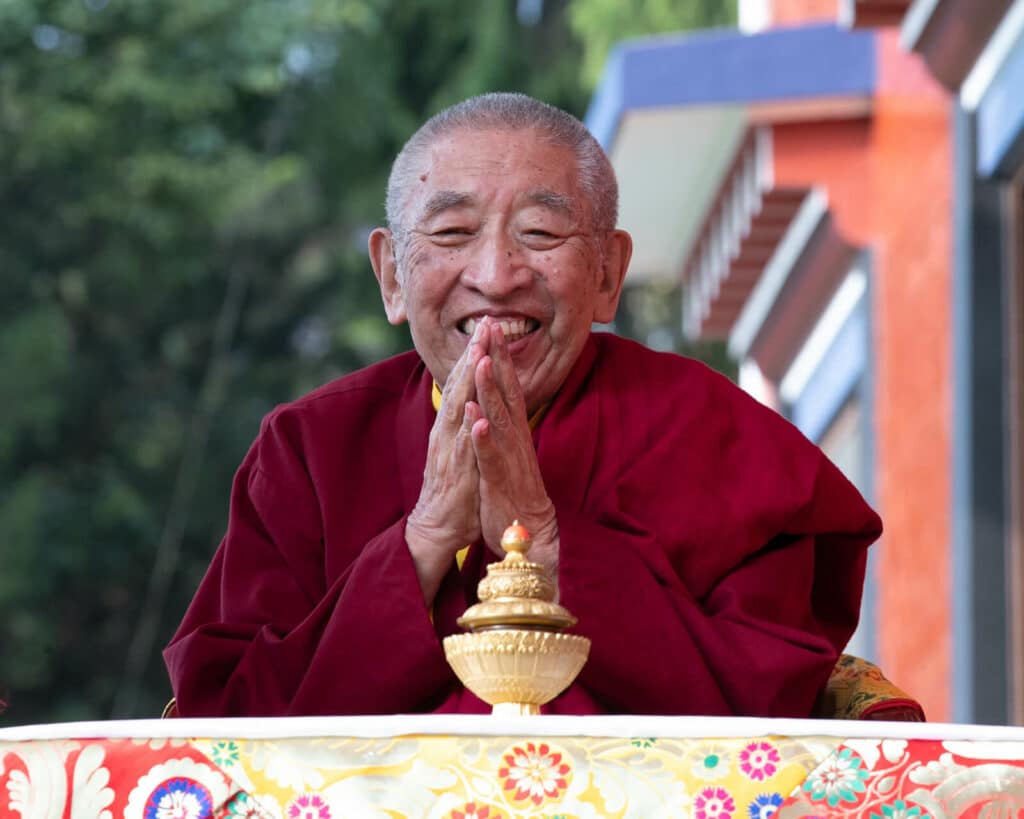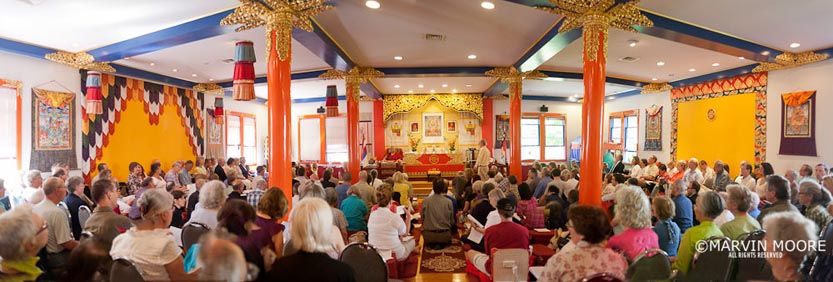
 In August 2011, Thrangu Rinpoche visited Halifax where he taught on Khenpo Gangshar’s text: Naturally Liberating Whatever You Meet. The weekend was attended by members of the Shambhala community, and by a number of Thrangu Rinpoche’s students from Maine and elsewhere. The three-day program was a testament to Thrangu Rinpoche’s generosity and tireless energy. He explicated these profound, and (from some point of view) ungraspable teachings, with piercing clarity and directness. In addition, he gave a public talk, and a youth audience. Before and after each of these formal teaching sessions, Rinpoche met with students, granted interviews, and/or worked on translation projects. At age 78, Rinpoche seemed to glide effortlessly through this busy schedule with precision, and an infectious sense of humor and delight.
In August 2011, Thrangu Rinpoche visited Halifax where he taught on Khenpo Gangshar’s text: Naturally Liberating Whatever You Meet. The weekend was attended by members of the Shambhala community, and by a number of Thrangu Rinpoche’s students from Maine and elsewhere. The three-day program was a testament to Thrangu Rinpoche’s generosity and tireless energy. He explicated these profound, and (from some point of view) ungraspable teachings, with piercing clarity and directness. In addition, he gave a public talk, and a youth audience. Before and after each of these formal teaching sessions, Rinpoche met with students, granted interviews, and/or worked on translation projects. At age 78, Rinpoche seemed to glide effortlessly through this busy schedule with precision, and an infectious sense of humor and delight.
For those who may not be familiar with Thrangu Rinpoche’s activities, and deep connections to the Shambhala community, here are some of the highlights.
- Thrangu Monastery is about 60 miles from Surmang, and there has always been a close connection between the two Kagyu centers. From that point of view, connections between the Thrangu and Trungpa tulkus have been forged for generations. In this lifetime, the 9th Thrangu and the 11th Trungpa met on several occasions while still in Tibet. They were ordained together by the 16th Karmapa, and were vajra brothers, having both studied directly and intensively with Khenpo Gangshar.
- During Thrangu Rinpoche’s first visit to Boulder in 1979, he showed the members of the Nalanda Translation Committee how to draw the two-dimensional Chakrasamvara mandala. He also helped them to translate a text that describes this mandala in great detail, as well as to decode similar passages in the Chakrasamvara sadhana itself. The translation group has worked on many texts under Rinpoche’s guidance over the years, and he continues to be one of their most important teachers and translation advisers. During the weekend program in Halifax, Rinpoche talked at some length about the importance of translation work. We hope to present a transcript of these comments on the Chronicles in the near future.
- In April 1980, Thrangu Rinpoche gave Vajrayogini teachings in Boulder. These teachings are included in the Vajrayogini practice manual.
- Thrangu Rinpoche visited Vajradhatu Seminary in Lake Louise in either 1980. While he was there, Trungpa Rinpoche shared with him the Shambhala terma teachings. Also during this visit, Thrangu Rinpoche met with senior students, studied Trungpa Rinpoche’s seminary transcripts, and familiarized himself with Trungpa Rinpoche’s unique skillful means and methods of teaching dharma and training students in the West. Following his visit to seminary, Thrangu Rinpoche began to teach more widely within the Vajradhatu mandala: visiting centers and giving teachings.
- Since Trungpa Rinpoche’s passing in 1987, Thrangu Rinpoche has become an invaluable mentor and guide for the Vajradhatu/Shambhala community, conferring abhishekas, training students in numerous ways, and serving as an important object of refuge for many of Trungpa Rinpoche’s heart students.
- One of Trungpa Rinpoche’s important aspirations was to establish a traditional Kagyu monastery in North America. Sometime around the mid 1980s, he asked some of his students to begin looking for land. When a property was found in Cape Breton, Trungpa Rinpoche established Gampo Abbey and asked Thrangu Rinpoche to serve as its abbot, a position that he has held for over twenty years.
- Starting in the mid-1980s, Trungpa Rinpoche began to receive requests from students who wished to enter into the traditional three-year retreat. Since all of the three-year retreat programs at that time were practiced in Tibetan, Trungpa Rinpoche advised his students to wait until this could be done in English. The Nalanda Translation Committee undertook the monumental task of translating the traditional Karma Kagyu three-year retreat liturgies and commentaries into English at the behest of Thrangu Rinpoche for the opening of the Sopa Choling retreat centre at Gampo Abbey. The translators worked on the various retreat texts beginning around 1990, with the first drafts completed as they were needed by the retreatants over a six-year period. Throughout this work, Thrangu Rinpoche remained their main adviser, along with Lama Ugyen and others. Many Western yogis and yoginis have completed the three-year retreat under Thrangu Rinpoche’s guidance at Sopa Choling over the past two decades.
- Perhaps the most indelible imprint that Thrangu Rinpoche has had upon the Vajradhatu/Shambhala community is the supplication that he composed at the request of Sakyong Mipham Rinpoche in 1992: Fulfilling The Aspirations Of The Vidyadhara The Venerable Chögyam Trungpa Rinpoche. This supplication conveys the depth of Thrangu Rinpoche’s understanding of the path that his vajra brother laid out for his students, including the stages of the Buddhist path, and the importance of the Shambhala teachings and terma treasures. This liturgy, which has been chanted at the end of the day in practice centers, programs, retreats, and practitioners’ homes for nearly two decades, has been an ongoing guidepost for Trungpa Rinpoche’s students.
Needless to say, the scope of Thrangu Rinpoche’s activities reach far beyond the Shambhala community. He was the khenpo and tutor to the four Kagyu princes, and he is one of the 17th Karmapa’s primary teachers and mentors. He presides over monasteries, monastic colleges, and retreat centers in Tibet, Nepal, India, and North America. He guides students in Malaysia, Taiwan, Nepal, North America and Europe. He has established the Shree Mangal Dvip Boarding School in Nepal that has provided a home, education and hope for many boys and girls who might otherwise be living in desperate conditions.
To learn more about Thrangu Rinpoche’s activities, visit Rinpoche.com.



